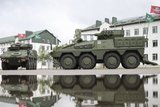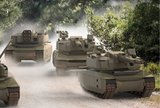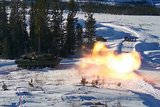Honeywell expands line of ballistic materials for hard armor applications
Honeywell announced today that it has expanded its Spectra Shield II line of ballistic materials for hard armor applications, including breast plates, helmets and vehicles that are lighter, work effectively in high temperatures and keep military personnel safer.
The new products, Spectra Shield II SR 3136 and SR 3137, absorb 2 to 6 times more energy than earlier-generation Spectra Shield hard armor products, reduce impact trauma by 10 percent, and have improved ballistic performance at high temperatures.
These new materials also enable lighter, more protective armor. They can lighten the load of both the soldier and the vehicles that transport them, and, when utilized as a key component of advanced armor systems, can help withstand a variety of threats, including armor-piercing rounds, improvised explosive devices and explosively formed projectiles.
"Honeywell's new Spectra Shield II ballistic products demonstrate our focus on developing tougher, lighter weight ballistic materials that can protect against increasingly lethal threats to military and law enforcement personnel," said Phil Wojcik, global business director for Honeywell's Advanced Fibers and Composites business. "This is another example of Honeywell's commitment to developing advanced materials to help protect men and women who serve in militaries and law enforcement agencies around the world."
Each of the new products has been tested at high temperatures and, when compared to current Spectra Shield products, can offer up to a 10 percent improvement in backface signature performance, minimizing the depressions caused by projectile impact. The new materials also showed a 5 percent improvement in ballistic performance when tested under these conditions.
Spectra Shield II is a composite material that incorporates Honeywell's super-strength Spectra fiber, which, pound for pound, is 15 times stronger than steel yet light enough to float. Shield technology is a patented Honeywell process designed to optimize the ballistic performance characteristics of Spectra, as well as aramid, fiber.
Spectra fiber is made from ultra-high molecular weight polyethylene using a patented gelspinning process. The fiber exhibits high resistance to chemicals, water, and ultraviolet light. It has excellent vibration damping, flex fatigue and internal fiber-friction characteristics. It has up to 60 percent greater specific strength than alternate aramid fiber.
Spectra Shield II products have been widely adopted and proven for the most advanced armor applications globally -- from bullet-resistant vests, breast plates, and helmets to combat vehicles and military aircraft -- where lightweight solutions and durability are critical.
Source: Honeywell
More from Land Warfare
-
![Hungary set to begin using Hero 400 loitering munitions]()
Hungary set to begin using Hero 400 loitering munitions
Developed by Israel's Uvision and with systems being sold in the thousands to multiple European NATO countries and the US, the Hero family of loitering systems is also in production in the US and Italy, the latter through Rheinmetall.
-
![Croatia orders Leopards and CAESAR howitzers as Lithuania orders more CAESARs]()
Croatia orders Leopards and CAESAR howitzers as Lithuania orders more CAESARs
The Leopard is becoming the tank of choice in central and eastern Europe as Croatia joins Lithuania, the Czech Republic and Hungary in ordering the platform. Lithuania and Croatia have also signed for CAESAR howitzers.
-
![Light Reconnaissance Strike – enabling a vital mission set (Studio)]()
Light Reconnaissance Strike – enabling a vital mission set (Studio)
A new system-of-systems concept will unlock digital integration of sensors and weapons for Light Forces, allowing them to shape the battlefield environment on their own terms and upgrade legacy platforms.























